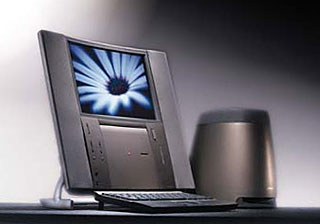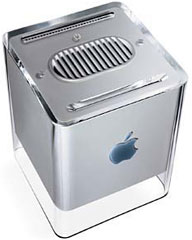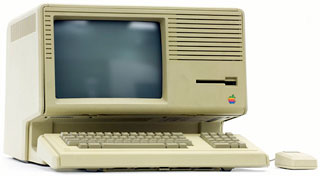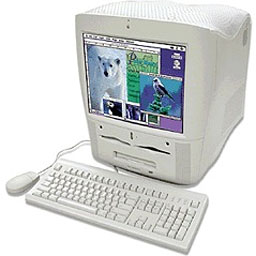Vintage Mac News is a roundup of news related to vintage Macs* and
other older Apple products. For other Mac and Apple news, see Mac News Review. For iBook, PowerBook, and other
portable news, see The 'Book Review.
iPad, iPod, iPhone, and Apple TV news is covered in iOS News Review.
Purchases made through links to Amazon.com and
Apple's iTunes/iBook/App/Mac App Store support Low End Mac.
News & Opinion
News & Opinion
The 5 Weirdest Macs Ever
Macworld's Benj Edwards muses:
"...if a company produces hundreds of computer models, chances are
that a few might come out looking a little too distinctive, little too
unique, or little too weird. Here are the five weirdest Macs ever
released by Apple.
5. Flower Power and Blue Dalmatian iMacs (2001)
 "About three years into the iMac G3's lifespan, Apple ran
out of colors. It had manufactured iMacs that were Bondi Blue,
Blueberry, Strawberry, Lime, Tangerine, Grape, Graphite, Indigo, Ruby,
Sage, and Snow."
"About three years into the iMac G3's lifespan, Apple ran
out of colors. It had manufactured iMacs that were Bondi Blue,
Blueberry, Strawberry, Lime, Tangerine, Grape, Graphite, Indigo, Ruby,
Sage, and Snow."
"In February 2001, Apple found the answer: It debuted iMacs with
multicolor patterns named Blue Dalmatian and Flower Power that came
molded into the case plastic."
"Some thought the new patterns were ugly, while others just secretly
barfed."
"Beneath their tacky exteriors, they were solid, dependable iMacs,
of course. But outside, they were both really weird, so they share a
tie for the number five position on this list."
4. Twentieth Anniversary Macintosh (1997)
 "If one were asked to name the most indulgent,
over-engineered personal computer ever created, one might casually
mention the Twentieth Anniversary
Macintosh. Then duck.
"If one were asked to name the most indulgent,
over-engineered personal computer ever created, one might casually
mention the Twentieth Anniversary
Macintosh. Then duck.
"Apple released the $7499-computer to celebrate its 20th anniversary
in business - almost a year after that anniversary had passed. The
machine cost more money than most individuals had . . . and its
resulting scarcity bred a cult-like following that persists to this
day."
3. Power Macintosh G4 Cube (2000)
 "Just after
Steve Jobs announced the Power Mac G4 Cube in 2000,
Apple fans immediately remembered the
cube-shaped NeXT Computer from 1988 and began to sense a pattern
emerging.
"Just after
Steve Jobs announced the Power Mac G4 Cube in 2000,
Apple fans immediately remembered the
cube-shaped NeXT Computer from 1988 and began to sense a pattern
emerging.
"Aside from those two computers, that theory has never really been
put to a good test. Perhaps some day Apple will release a hoard of
cube-shaped iPod prototypes (with cube-shaped earbuds - ouch!). Until
then, I'll admit that the only two notable cube-shaped PCs released in
the United States arrived under the purview of Jobs. So yes, he
probably liked cubes."
2. Macintosh XL (1985)
"You're looking at the original Hackintosh. That's what folks called
the Macintosh
XL back in the mid-1980s, because the product featured the body of
an Apple Lisa 2/10 and the brain of a Mac.
 "The Lisa
debuted in 1983 (predating the Macintosh by one year) with the
exorbitant price of $9995 (mistake number 1). Understandably, sales
were slow. Apple attempted to revitalize the Lisa line with the release
of the Lisa 2, which launched alongside the first Macintosh in
January 1984 (mistake number 2). Macs outsold Lisas by a huge margin,
and Apple knew the Lisa platform was doomed.
"The Lisa
debuted in 1983 (predating the Macintosh by one year) with the
exorbitant price of $9995 (mistake number 1). Understandably, sales
were slow. Apple attempted to revitalize the Lisa line with the release
of the Lisa 2, which launched alongside the first Macintosh in
January 1984 (mistake number 2). Macs outsold Lisas by a huge margin,
and Apple knew the Lisa platform was doomed.
"Seeking to clear out existing Lisa 2 inventory, Apple bundled the
unit with Macintosh emulation software and re-branded it as the
Macintosh XL. It launched in January 1985 as part of the Macintosh
Office system.
"To Apple's surprise, high-end consumers snapped up the $3995
Macintosh XL in dramatic fashion, buying up Apple's entire supply
within five months of its release.
"With 2 MB of RAM and a 10 MB internal hard drive (at a time when
the most powerful 'regular' Mac included a non-upgradeable 512 KB of
RAM and no hard drive), the Mac XL seemed a bargain for users who
wanted a Mac with enough memory to actually be useful. It even sported
a higher display resolution than its smaller Mac cousin (608 by 431
versus 512 by 342 on the original Mac)."
1. Power Macintosh G3 All-In-One (1998)
 "Pop quiz: Name the first partly translucent all-in-one
Macintosh. If you said 'iMac,' you'd be horribly, terribly mistaken.
But we'd all forgive you for thinking that.
"Pop quiz: Name the first partly translucent all-in-one
Macintosh. If you said 'iMac,' you'd be horribly, terribly mistaken.
But we'd all forgive you for thinking that.
"No, that honor goes to the Power Macintosh G3
All-In-One, announced in March 1998 - a mere two months before the
iMac. Amazingly, this 59-pound beast of a machine slipped in under
Steve Jobs's watch, although you can be assured that this molar-shaped
monstrosity traces its origins to a time before he took charge."
Link:
The Five Weirdest Macs of All Time
Et Tu, Low End Mac? Et Tu?
PPC Luddite's Dan writes:
I'm a bit late on this because I spend the bulk of my time proving
my horrible time-management skills instead of checking my email, but I
just saw the minor brouhaha that started when Zen at PowerPC Liberation
put up an excellent post about Linux keeping PowerPC relevant. Well,
Low End Mac responded with the following:
We love old Macs here at Low End Mac, and we've
fiddled with BSD and Linux from time to time, but I take just the
opposite perspective here. Windows is huge. Macs are big. Linux is
small, maybe 2-3% of the desktop market, and most Linux software is
compiled for x86 PCs, not old PowerPC Macs. Further, going from the
Classic Mac OS or Mac OS X to Linux is a giant step backward in ease of
use. Sure, it may be more secure, but we're Mac users because we love
the Mac experience. Ditching the Mac OS for Linux is like taking a
luxury car and replacing the automatic transmission because you want
more control. I'd rather enjoy the smooth ride and the scenery than
think about shifting gears, so even though I do have a Linux box here
at Low End Mac headquarters, it's not a bastardized Mac. My
2¢.
And Low End Mac's Daniel Jansen added in Zen's comment section:
We're linking to your article in this week's Vintage
Mac News, and while I wish you and other PPC Linux users the best, I
think you're only creating an even smaller platform.
Ouch. I have to say, I'm vaguely insulted by all this talk about
Linux not being user-friendly given my widely disseminated and
universally acclaimed
install guide that if followed faithfully and with a true heart
will lead to the user-friendliness that Mac users crave.
If you saw my install guide posts earlier but not lately, I've spent
the last several weeks revising and adding to them. I've added several
sections to Part IV, including Gamma Settings, Trackpad, CPU Frequency
Scaling, Fonts, Search, and GTK Themes. Also, I turned the Graphics
Acceleration section into a short novel. If you're like me you can
spend way too much time googling information for your own personal
install guide, but feel free to crib off mine and hopefully it'll save
you some time. ;)
In the meantime I, and I expect others, will keep writing about
Linux because with OS X dead on PowerPC and increasingly restrictive
toward developers on Intel, it's becoming less interesting these
days.
And to prove me right, Zen is promising more posts about Lubuntu
including an install guide.
Publisher's note: I'll admit to not having run any version of Linux
on PowerPC Macs in quite a while. I honestly don't see the point,
because my OS X 10.4 Tiger and
10.5 Leopard G4 Power Macs do almost everything I
need to do - and the few things they can't do well can be done on my
2.0 GHz Intel-based 2007 Mac
mini. Why learn another operating system and new software (often
far less polished than Classic Mac apps) when my PPC Macs remain
perfectly useful running OS X?
I do have Ubuntu 12.04 installed on a 2.8 GHz Pentium 4 computer,
and while it works and has more up-to-date apps than my PPC Macs, Linux
is as alien to me as Windows, which I've also used very rarely.
Low End Mac has long supported the efforts of the Linux PPC
community, but until now it has never amounted to much. Maybe PPC
Luddite and PowerPC Liberation can change that, and I certainly
wouldn't mind setting up an old G3 or G4 Mac with Debian or Lubuntu at
some point, but I guess I just haven't reached the point where I need
an alternative operating system. Although Apple and most developers no
longer support it, OS X on PPC is far from dead. dk
Link: Et
Tu, LowEndMac? Et Tu?
Lubuntu Loves My Upgraded Blue & White G3
PowerPC Liberation's Zen says:
"Last night I setup Lubuntu 12.04
on my Stormtrooper (B&W G3 w/G4 500 MHz, 1
GB RAM) and it runs beautifully. With OS X my 400 MHz Sawtooth is normally a
bit faster than this machine even with a 100 MHz faster CPU because of
the faster memory controller in the Sawtooth. This is not the case with
Lubuntu at all....
"Another item worthy of note is that of the 5 video cards I have
used in all my testing Lubuntu likes a Radeon 7000 PCI the best . . .
None of them work quite as well as the 7000 PCI....
"I have tried every version of Linux available for PowerPC and
Lubuntu is my favourite by far. I would put Debian Squeeze and Mint
about tied for second."
"In terms of the Ubuntu family only Lubuntu gets my personal
approval. I have tried every single one and while they are all complete
enough to be usable, only Lubuntu is lightweight enough to match and
even surpass Debian performance. Some people think that installing LXDE
in Ubuntu will produce the same OS which is not the case at all. The
lightweight ideology of Lubuntu goes much deeper than the GUI. Lubuntu
has the balance that any good OS needs which is great performance
combined with full capability.
"In the next few days I will post a full Lubuntu install guide since
I have had a lot of emails and a few comments asking for help. I will
take you from downloading and burning the iso right through to having
it fully setup for use."
Link removed at the request of PowerPC Liberation.


 "About three years into the iMac G3's lifespan, Apple ran
out of colors. It had manufactured iMacs that were Bondi Blue,
Blueberry, Strawberry, Lime, Tangerine, Grape, Graphite, Indigo, Ruby,
Sage, and Snow."
"About three years into the iMac G3's lifespan, Apple ran
out of colors. It had manufactured iMacs that were Bondi Blue,
Blueberry, Strawberry, Lime, Tangerine, Grape, Graphite, Indigo, Ruby,
Sage, and Snow." "If one were asked to name the most indulgent,
over-engineered personal computer ever created, one might casually
mention the
"If one were asked to name the most indulgent,
over-engineered personal computer ever created, one might casually
mention the  "Just after
Steve Jobs announced the
"Just after
Steve Jobs announced the  "The
"The  "Pop quiz: Name the first partly translucent all-in-one
Macintosh. If you said 'iMac,' you'd be horribly, terribly mistaken.
But we'd all forgive you for thinking that.
"Pop quiz: Name the first partly translucent all-in-one
Macintosh. If you said 'iMac,' you'd be horribly, terribly mistaken.
But we'd all forgive you for thinking that.

